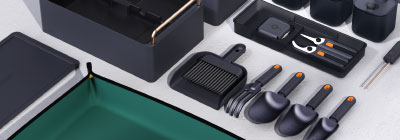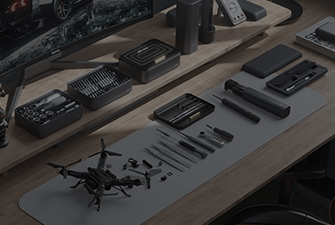
A well-prepared tool box stands as a professional's main asset for routine tasks like evaluating lumber and securing screws exactly. This resource gives insight to opt for correct tools and apply them successfully.
- Initiate your toolkit by collecting essential hand tools like a hammer, screwdrivers, wrenches, pliers, saws, and tapes.
- Understand each implement's function and the particular applications they serve.
- Develop techniques through active projects, gradually making tasks more complex.
Note that dedicating time to hand tool mastery improves your abilities. With sound knowledge, tools become reliable extensions of ability to finish intricate projects with confidence.
Boost Project Efficiency with Power Tools
Eager to upgrade work? Step into the dynamic world of power tools uniting precision and productivity. These indispensable devices can reshape how you work, for pros and hobbyists alike. From heavy-duty drills to intricate saws, power tools offer a spectrum of capabilities to tackle any construction project with ease.
- Employ cordless impact drivers for fast and effortless fastening and demo activities.
- Perfect use of reciprocating saws to achieve speedy and clean cuts across materials.
- Upgrade woodworking techniques with efficient planers and jointers for refined finishing.
Implement power tools to reduce build time and boost quality of results.
Accuracy Simplified
In precise work, appropriate measuring tools are the key differentiator. From simple straight edges to high-precision micrometers, essential measuring tools enable accurate realization of concepts. Whether long-time professional or budding enthusiast, gaining measurement mastery creates new opportunities.
- Investigate the wide selection of measuring devices catering to varied needs.
- Study the purposes and gains offered by different measurement tools.
- Refine abilities in accurate measurement and proper implementation.
Kits for Every Job
Whether you're a seasoned professional or a DIY enthusiast, having the right tool set is essential for tackling any project. For diverse tasks including assembly and fastening, the perfect toolset supports accuracy and safety. Choose tool collections aligned with the tasks you will perform repeatedly.
Will a comprehensive multi-tool set be useful or is a specialized kit sufficient? Once you know what you need, survey options to compare features, build quality and price. Check online user reviews to obtain helpful input before finalizing your selection.
With a little research and planning, you can find the perfect tool set that will empower you to accomplish any project with confidence.
Hand Tool Care for Long-Term Reliability
Keeping hand tools well-maintained is necessary for any dedicated craftsman. Without upkeep tools will dull, break and create aggravating work issues. Sustained care maintains tools in top condition for prolonged reliable use. Make cleaning tools a habit after each use to clear contaminants. Place tools in dry, protected storage to inhibit rust and corrosion.
- Use a honing stone or file periodically to keep blade edges sharp.
- Apply correct lubrication to parts in motion to reduce friction and extend durability.
- Inspect grips routinely for wear and substitute damaged handles as necessary.

Following these basic care steps helps extend tool life and improve work efficiency and satisfaction.
Fundamental Hand Tools for Your Workshop
A complete workshop becomes an inviting workspace for enthusiasts and hobbyists. Specialty instruments help, but a strong set of basic tools is essential for most projects. Recommended basics are a reliable hammer, adjustable wrench and quality tape measure for accurate gauging. Remember to have varied screwdrivers, pliers for manipulation and a utility knife for slicing materials. A sturdy saw is key for precise cuts and a level guarantees aligned, even work.
- Home Workshop Essentials: Hand Tools

Power Tool Safety: A Practical Handbook
Power tools constitute robust equipment delivering significant power and productivity. Still, these machines call for careful understanding of safety practices. Skipping proper safeguards can produce significant injury risks. This guide sheds light on power tool safety and provides the practices to engage responsibly.
Start out by learning your tools: read guides carefully and understand their protective features. Always put on correct PPE such as safety goggles, ear protection and gloves. Inspect and service tools routinely to verify reliable operation.
Keep in mind safety remains paramount in every workspace. Complying with these precautions ensures you can use power tools safely and with confidence.
Choosing Measuring Instruments for Precision
When it comes to achieving precise measurements, the tools you select can make a significant difference. Several types of measurement tools are available, each meant for certain tasks. Understanding distinctions between tools is central to informed choosing. Factors such as accuracy, resolution, and measurement type should be carefully evaluated when selecting the right tool for the job.
- For accurate length measurements, a ruler or tape measure is typically used.
- To determine angles correctly, rely on a protractor.
- Calipers—especially digital—are perfect for measuring small features.
By carefully selecting the appropriate measuring tools, you can ensure accurate and reliable results.
Selecting the Ultimate Toolkit

Starting the process of selecting a toolkit can feel thrilling yet overwhelming. Facing numerous options often leads to decision overwhelm. This wide-ranging guide offers advice to pick the perfect tool set for your needs.
First, evaluate the kinds of projects you will commonly perform. Are you experienced or new to the craft? Explicitly setting goals streamlines selection.
- Don't be afraid to combine blend utilize both power and hand tools for a successful productive efficient outcome Utilize both categories of tools to achieve efficient, successful project results Employ a blend of power and manual tools to reach productive and precise outcomes
- Emphasize primary essential items
- A reliable hammer, mallet or sledgehammer
- A versatile set of screwdrivers, wrenches and pliers is important
- Measuring Tape Ruler Tape
- Leveling tools like level, plumb bob or transit
Reflect on construction materials, price limits and brand trustworthiness. Recall that durable toolsets offer long-run value.
Tackle Your Projects with Confidence: Mastering DIY Tools
Beginning DIY ventures often feels daunting. Yet with fitting tools and skillful knowledge, difficult tasks turn into wins. Start by getting to know and learning about each tool. Study the instructions carefully and practice essential techniques in safety. Remember, safety should always be your top primary first priority. Wear protective safety guard gear like goggles, gloves, and earplugs to shield protect defend yourself from potential hazards.
Choosing tools, pay attention to durability and structural sturdiness. Pick manufacturers with reliable reputations for long-term tool performance.
Consult seasoned DIYers or knowledgeable staff at your local hardware or home improvement store. Experts and veteran DIYers can give guidance and suggestions to pick the right tools for projects.
- Always use sharp tools for safer, cleaner work.
- Store your tools properly to prevent damage or loss.
- Expand your skills and knowledge through DIY
Selecting Between Power and Hand Tools: Usage Guide
When working on tasks, choosing power vs hand tools often proves challenging. While powerful robust heavy-duty power tools offer speed and efficiency, classic hand tools remain essential valuable indispensable for precise work and smaller jobs. Here's a breakdown guide to help you select choose pick the right option tool equipment for the job.
- Hand tools provide superior control for detailed assembly, carving and intricate repairs. They afford better control while usually being easier on the budget.
- For time-saving tasks like cutting, boring holes, and sanding, power tools are most effective. They dramatically reduce time and manual labor required.
In conclusion, the best tool option is based on task specifics, user experience and budgetary constraints. Mixing hand and power tools often yields the best, most efficient outcomes.
